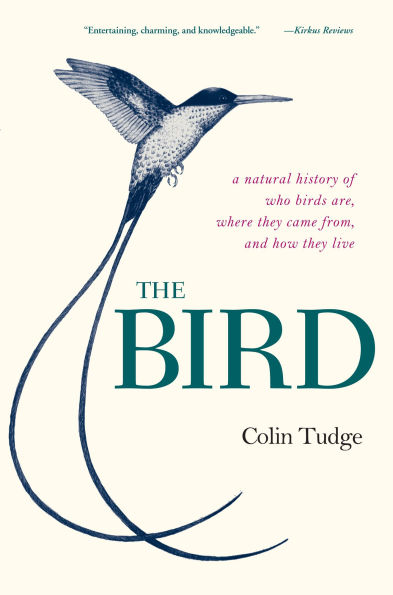The Bird: A Natural History of Who Birds Are, Where They Came From, and How They Live
Chosen as a best book of the year by The Independent
Complete with an "annotated cast list" of all the known birds in the world—plus gorgeous illustrations—The Bird is a comprehensive and delightfully accessible guide for everyone from dedicated birders to casual birdwatchers that celebrates and illuminates the remarkable lives of birds.
In this fascinating exploration of the avian class, Colin Tudge considers the creatures of the air. From their evolutionary roots to their flying, feeding, fighting, mating, nesting, and communicating, Tudge provocatively ponders what birds actually do–as well as why they do it and how. With the same curiosity, passion, and insight he brought to redwoods, pines, and palm trees in his widely acclaimed book The Tree, Tudge here studies sparrows, parrots, and even the Monkey-eating Eagle to better understand their world–and our own.
There is far more to a bird's existence than gliding gracefully on air currents or chirping sweetly from fence posts–the stakes are life and death. By observing and explaining the complex strategy that comes into play with everything from migration to social interaction to the timing of giving birth to young, Tudge reveals how birds are uniquely equipped biologically to succeed and survive. And he offers an impassioned plea for humans to learn to coexist with birds without continuing to endanger their survival.
1101890151
Complete with an "annotated cast list" of all the known birds in the world—plus gorgeous illustrations—The Bird is a comprehensive and delightfully accessible guide for everyone from dedicated birders to casual birdwatchers that celebrates and illuminates the remarkable lives of birds.
In this fascinating exploration of the avian class, Colin Tudge considers the creatures of the air. From their evolutionary roots to their flying, feeding, fighting, mating, nesting, and communicating, Tudge provocatively ponders what birds actually do–as well as why they do it and how. With the same curiosity, passion, and insight he brought to redwoods, pines, and palm trees in his widely acclaimed book The Tree, Tudge here studies sparrows, parrots, and even the Monkey-eating Eagle to better understand their world–and our own.
There is far more to a bird's existence than gliding gracefully on air currents or chirping sweetly from fence posts–the stakes are life and death. By observing and explaining the complex strategy that comes into play with everything from migration to social interaction to the timing of giving birth to young, Tudge reveals how birds are uniquely equipped biologically to succeed and survive. And he offers an impassioned plea for humans to learn to coexist with birds without continuing to endanger their survival.
The Bird: A Natural History of Who Birds Are, Where They Came From, and How They Live
Chosen as a best book of the year by The Independent
Complete with an "annotated cast list" of all the known birds in the world—plus gorgeous illustrations—The Bird is a comprehensive and delightfully accessible guide for everyone from dedicated birders to casual birdwatchers that celebrates and illuminates the remarkable lives of birds.
In this fascinating exploration of the avian class, Colin Tudge considers the creatures of the air. From their evolutionary roots to their flying, feeding, fighting, mating, nesting, and communicating, Tudge provocatively ponders what birds actually do–as well as why they do it and how. With the same curiosity, passion, and insight he brought to redwoods, pines, and palm trees in his widely acclaimed book The Tree, Tudge here studies sparrows, parrots, and even the Monkey-eating Eagle to better understand their world–and our own.
There is far more to a bird's existence than gliding gracefully on air currents or chirping sweetly from fence posts–the stakes are life and death. By observing and explaining the complex strategy that comes into play with everything from migration to social interaction to the timing of giving birth to young, Tudge reveals how birds are uniquely equipped biologically to succeed and survive. And he offers an impassioned plea for humans to learn to coexist with birds without continuing to endanger their survival.
Complete with an "annotated cast list" of all the known birds in the world—plus gorgeous illustrations—The Bird is a comprehensive and delightfully accessible guide for everyone from dedicated birders to casual birdwatchers that celebrates and illuminates the remarkable lives of birds.
In this fascinating exploration of the avian class, Colin Tudge considers the creatures of the air. From their evolutionary roots to their flying, feeding, fighting, mating, nesting, and communicating, Tudge provocatively ponders what birds actually do–as well as why they do it and how. With the same curiosity, passion, and insight he brought to redwoods, pines, and palm trees in his widely acclaimed book The Tree, Tudge here studies sparrows, parrots, and even the Monkey-eating Eagle to better understand their world–and our own.
There is far more to a bird's existence than gliding gracefully on air currents or chirping sweetly from fence posts–the stakes are life and death. By observing and explaining the complex strategy that comes into play with everything from migration to social interaction to the timing of giving birth to young, Tudge reveals how birds are uniquely equipped biologically to succeed and survive. And he offers an impassioned plea for humans to learn to coexist with birds without continuing to endanger their survival.
23.0
In Stock
5
1

The Bird: A Natural History of Who Birds Are, Where They Came From, and How They Live
480
The Bird: A Natural History of Who Birds Are, Where They Came From, and How They Live
480
23.0
In Stock

Product Details
| ISBN-13: | 9780307342058 |
|---|---|
| Publisher: | Crown Publishing Group |
| Publication date: | 09/07/2010 |
| Pages: | 480 |
| Product dimensions: | 9.48(w) x 11.28(h) x 1.04(d) |
About the Author
From the B&N Reads Blog
